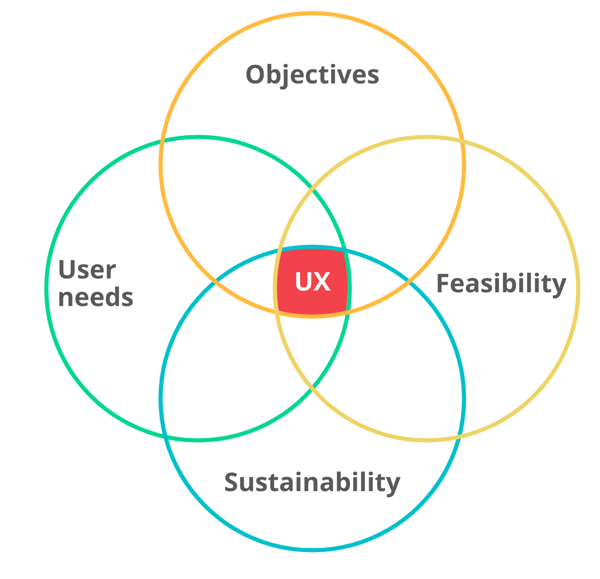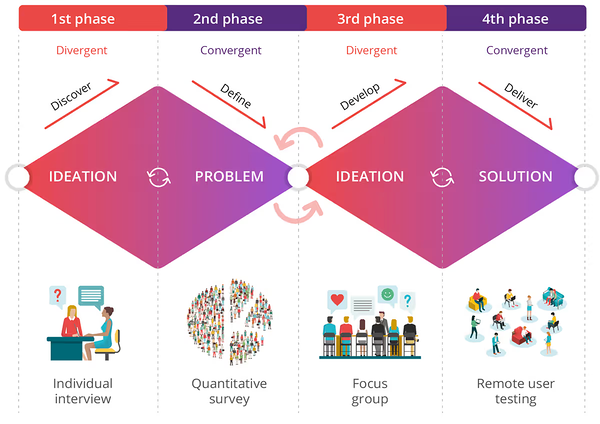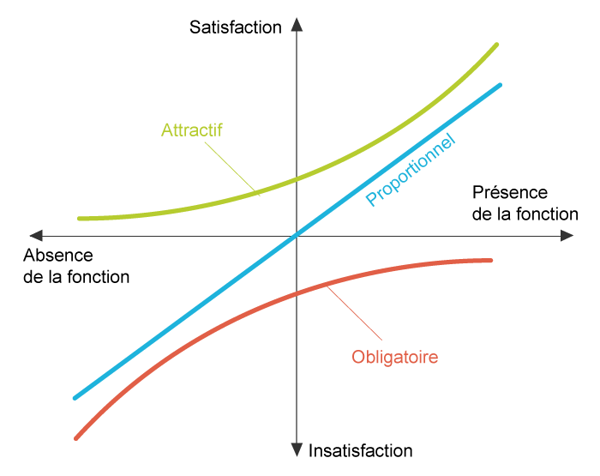September 22, 2023
What's the best way to build your digital roadmap?
If you work in the digital sector and are experienced in project management, you've probably already created a digital roadmap. This indispensable tool enables you to list your objectives, define the actions to be taken and prioritize them. That's for the form. But what about the content within? Are you sure that your market research data really applies to your business? If you're planning to launch (or not) a digital product or service in the near future, you'd better be sure. To embark on your digital transformation with confidence, you need to gather customized data. There's only one way to do this. It's scientific, and it allows you to build a reliable digital roadmap.
The digital roadmap, the keystone of your digital projects
If you're planning to create digital solutions in the near future, chances are you've set yourself short, medium and long-term objectives. Congratulations, that's a good start. These probably even meet the requirements of the SMART acronym: Specific, Measurable, Attainable, Realistic and Time-bound. Ferpect! Now all you have to do is define and prioritize the actions that will enable you to achieve these objectives.
Roadmap digitale : What is a digital roadmap? ce que c’est ?
The "digital roadmap" is a simplified graphic representation of the various stages of a project. It enables the company to set a course, with different objectives. This document is not set in stone, and can evolve as the project progresses. The digital roadmap is part of an agile method. It enables information to be communicated and shared with the various players involved. A good digital roadmap should always reflect the company's values and vision.
🏆 One of the keys to successful projects is listening to your customers. Our Product Designer explains how in this webinar!
*Please note that the video is in French and has English subtitles.
📗 No time to watch the video now? Download our white paper!
Listening to your users for greater agility.
Who is a digital roadmap for?
Companies who are aware that digital technology offers immense development prospects, but who don't know how to begin (or continue) their digital transition. A digital roadmap may, for example, be necessary when creating or redesigning a website. But also when developing a smartphone application. A digital roadmap can also be used to set up a chatbot or improve a user experience. A digital roadmap can be applied in a wide variety of ways. It can be used not only to validate an idea, but also to mark out the start and follow-up of a project, once the concept has been confirmed.
Why is it essential to define a launch schedule?
Because "What gets measured gets managed". We're not saying this ourselves, it's Peter Drucker, the famous business management specialist. But we agree with him. Especially when it comes to project management: deadlines are long, there are many players and setbacks are inevitable. All the ingredients are there for stakeholders to lose focus and lose sight of their objectives.
UX Research, the only truly reliable method for creating your digital roadmap
If you're familiar with project management, you've probably already followed a three-step process: assessment, analysis and recommendations. And in essence, we agree. Except that at Ferpection, we like to be precise. Of course, there's no such thing as perfection. But there are ways of getting closer. And user research is one of them. And why is that? Because UX research is at the crossroads of user needs, business objectives, technical feasibility and corporate responsibility. It enables the creation of a pragmatic digital roadmap that truly creates value.
The double diamond framework, a scientific method
Derived from design thinking, this approach responds to innovation issues. And in our opinion, it's the only truly reliable method for implementing a digital project. And why? Because it's based on science. Unlike market research found on the Internet, here we put the user at the heart of the process. This user-centric method produces data from a real sample. Decisions are therefore made on the basis of proven facts. Not approximations. By alternating divergent and convergent phases, the double-diamond method makes it possible to collect both qualitative and quantitative data.
First diamond: defining the problem
- We start with a discovery phase. This immersive phase enables us to observe and understand users' motivations, needs, expectations and obstacles. This is a divergent and ideation phase. One-on-one interviews are particularly useful at this stage of the process.
- The second phase is convergent. A single problem needs to be defined from among those identified in phase 1. Quantitative research is ideal for this purpose.
📮 Want more value-added content? Subscribe to our monthly newsletter. You'll learn the best practices of UX Research, always in a fun way 🙂
Second diamond: delivering a solutionn
- Now let's discuss the third stage. Like the first phase, this one is divergent. Its aim is to develop as many ideas as possible in response to the defined problem. Focus groups are the perfect way to reap the benefits of collective intelligence.
- Finally, the fourth stage of the process consists of delivering a solution. This is a convergent phase during which the team chooses the best response to the identified problem. The result is a prototype. Remote user testing is the ideal way to test the prototype.
🚙 This is exactly the method we used to support Bip&Go in the development of their new mobile application. Our customer was convinced that some of their users' needs were unmet. They wanted to deepen their understanding of market expectations before bringing his digital project to fruition. Find out more about the launch of their new mobility offering!
A user-centric prototype
The double diamond method has a number of advantages. Firstly, it is an agile method. It encourages collaboration between teams and offers great flexibility. It is possible to stop the process after the first diamond, or to return to a previous stage. The aim of this approach is to deliver a prototype quickly. Of course, it doesn't have to be perfect. It must correspond to the Minimum Viable Product (MVP), i.e. the most minimalist version possible, so that it can be tested by users.
In UX Research, different approaches are used to select the functionalities to be included in the MVP and, by extension, in the digital roadmap. The Kano model is one of them. It measures user satisfaction according to whether a feature is present or absent in the product. User feedback is collected using the Kano questionnaire. This value-creating approach enables us to improve the prototype as we develop. The main benefit of this type of agile approach is that the project progresses rapidly.
🧰 Interested in prototyping? Discover 5 tools to create your web and mobile prototypes!
5 steps to create your project roadmap with user research
Now you know how to collect the most reliable data science has to offer. And that's a good thing. You can now look forward to your digital transformation with greater peace of mind. Now let's see how to analyze and organize this data into an effective project roadmap.
1 - Analyze what already exists to make a diagnosis
When you buy a market study from a survey institute, you're collecting general data (declarative, behavioral and sectoral). This data can be useful for confirming or denying a trend. Unfortunately, however, they are not reliable enough to form the basis of your entire digital strategy. But why? Because it's not personalized! And yet, if you want to ensure that your future digital offerings correspond to the needs of your market, this is precisely the kind of data you need.
2 - Improve customer knowledge
If you're thinking of launching new digital services in your company, it may be a good idea to improve your customer knowledge. Of course, you know your target audience. But maybe not as well as you need to in order to make your digital transition a success. What is your core target? Do you know each of your personas in detail? Do you know every touchpoint in your customers' and prospects' customer journeys? When was the last customer survey carried out? It's possible that elements of your market have changed since then. Don't take the risk of making strategic decisions based on obsolete data.
3 - Audit existing journeys
Prospects and customers are one component of your market. But there are others, such as competitors. By carrying out a competitive benchmark, you can adapt your digital strategy, and even your corporate strategy. Carry out a 360° inventory of existing journeys, but also of your internal operations. Be exhaustive, so you don't miss out on important information. Conduct interviews with various departments and stakeholders. Both internally and externally. Objectives, Key Performance Indicators (KPIs)... Gather everyone's expectations. Based on this assessment, identify areas for improvement.
4 - Model typical profiles and user paths
Congratulations! You've reached the most rewarding phase of the project. You now have everything you need to accurately model :
- personas (also known as buyer personas, marketing persona, customer avatars or customer archetypes);
- customer journey) as well as points of contact
🧔🏻 If you'd like to know how to create a persona, we'll show you our method in this article!
5 - Create an actionable digital roadmap
Creating a digital roadmap is good. Creating a directly applicable digital roadmap is even better! To do this, your strategic plan must list the various actions to be carried out in chronological order. Each action must be prioritized. To do this, create a chart that defines, for each action :- Its use value. Will this action solve a previously identified problem? (For example, improving the user experience on your website). If so, to what extent?
- Financial value. Will this action make money for the company? (For example, improving the user experience on your website can boost your conversion rate). If so, to what extent? (Estimate the amount and timeframe of the gain).
- Complexity. Is this action difficult to implement? Does it require a lot of time? Resources?
Evaluate each action according to these three criteria. For each, give a score from 1 to 5. This will give you a ranking of your tasks. Those with the highest scores should be given priority. Actions that get fewer points but are not complex to carry out can, however, be implemented quickly. These are known as quick wins. The results of these quick wins are important for motivating your teams. In addition to the timetable, your roadmap should include a budget plan. This will ensure that the digital projects you have in mind are economically viable.
Whatever the nature of the digital products or services you wish to launch, creating a digital roadmap is an essential step. It will guide you and your teams, like a lighthouse in the night. Above all, it will ensure that you don't lose sight of your objectives. However, if you want to take full advantage of this powerful tool, borrow the techniques of UX research to make your data as reliable as possible. It would be a shame to miss out on a great opportunity because its potential has been poorly assessed. Or, conversely, to launch a dead-end digital product onto the market.
✅ Would you like us to help you build your digital roadmap? That's a great idea. A successful digital transition can't be improvised. Contact our UX Research consultants, they'll be happy to help.
All articles from the category: User research | RSS




